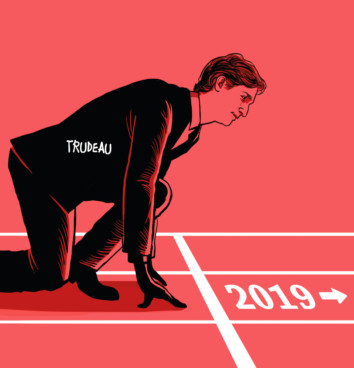
Canadians like to brag about the shortness of their prime ministerial elections in contrast to the agonisingly long presidential contests of the United States — a bit of self-flattery that’s true only in the narrowest sense. According to campaign law, Canada’s 2015 national election lasted a mere 11 weeks, but if we want to get technical, a close reading of the Federal Election Commission rulebook says the 2016 contest between Donald Trump and Hillary Clinton comprised a brisk 13-week period between the party conventions in the summer and voting day in early November.
In reality, of course, both countries consider their elections to have de facto started the second it becomes obvious who will be leading the major parties into battle. With Andrew Scheer having already been appointed leader of the Conservative Party of Canada back in May, this month’s selection of Jagmeet Singh as head of the New Democratic Party (NDP) means Canada has now officially passed that mark — a full two years before the October 21, 2019, general election. While a lot can and will happen in Canadian politics before then, the world nevertheless enjoys a pretty clear view of the shape of debate that will consume the country as Prime Minister Justin Trudeau fends off two competent rivals to seek a second term.
While the three would-be PMs represent distinct ideological traditions — Trudeau and Singh on the Left with Scheer on the Right — their similarities are substantial.
All men were born in the 1970s, for one, making this Canada’s youngest-ever prime ministerial contest. As a consequence of their youth, all have resumes dominated by politics at the expense of much else — Trudeau was a infamous dilettante before getting elected to parliament at age 36; Singh joined the Ontario legislature when he was 32, after working briefly as a lawyer, while Scheer hadn’t even completed his bachelor’s degree when he became an MP in 2004 at 25.
Though none can be fairly described as “millennial”, all personify youthful incarnations of their political movements.
Trudeau, as much of the world already knows, has achieved great success marketing himself as a sort of post-Barack Obama Obama, thoroughly literate in the vocabulary of tolerance and sensitivity that has come to define modern progressivism. The woke and winsome Singh offers similar appeal, and as the first non-white, non-Christian to lead a major Canadian party, he boasts an authenticity advantage. The pitch is more than a tad ironic, however, given progressive NDP voters tend to bash Trudeau precisely for using style to conceal a lack of skill. How exactly doubling down on charisma will make any easier the impossible tasks the Canadian Left has assigned itself — appeasing aboriginal people, achieving a perfect balance between environmental and economic anxiety — remains cryptic.
Conservative leader Scheer, meanwhile, while far from the alt-right, does embody a certain other stereotype of conservative youth — as the Onion put it, “young voters who dress and act like they’re already 50 years old”. A former party staffer who venerates former United States president Ronald Reagan and former United Kingdom prime minister Margaret Thatcher, strenuously opposes tax hikes and was (until recently) a reliable foe of abortion, his squeaker election to the Tory leadership was a victory for consensus conservatism in the face of wilder alternatives.
Yet, establishment orthodoxy also brings the nervousness of young conservatives who feel chronically misunderstood, and with it, a desire to be liked by being “uncontroversial”, particularly on polarising social issues. Scheer has thus spent the first few months of his low-profile leadership wishing immigrant communities a happy this-or-that, and trying to distance himself from the politically incorrect outbursts of some of the less-disciplined members of his caucus. Yet, he never goes quite as far in that direction as some may like either, highlighting the difficult dance of a conservative politician in an era when so many on the right believe the primary purpose of centre-right politics is resisting the censorial power of the Left.
The first election following the ascension of a new Canadian prime minister is rarely that interesting or consequential. Often the results differ little from the previous outcome, and with three candidates who don’t seem particularly disposed to expand their party’s base, 2019 could be little different.
A mild decrease in his current popularity could see Trudeau’s Liberal Party lose a few seats to the Conservatives or NDP in swing districts. Singh could perhaps make inroads in immigrant-heavy suburbs, but lose seats in Quebec on account of what we’re supposed to euphemistically call his “outward religiosity” alienating many “secular” French Canadian voters. His obsession with beating Trudeau at the social justice game could similarly turn off some voters in rural NDP areas who traditionally expect the party to feign some blue-collar bona fides — though only if Scheer can market himself as a conservative with vaguely United States President Donald Trump-like counter-appeal (a tall order).
Even a mildly weakened re-election for Trudeau would give the two opposition leaders enough victory to save face, and given their age, both could easily justify hanging around for a rematch in 2023, when Trudeau would presumably seek a fairly precedented third term.
How’s that for a long election?
— Washington Post
J.J. McCullough, a political commentator and cartoonist from Vancouver, is a columnist at Loonie Politics.









